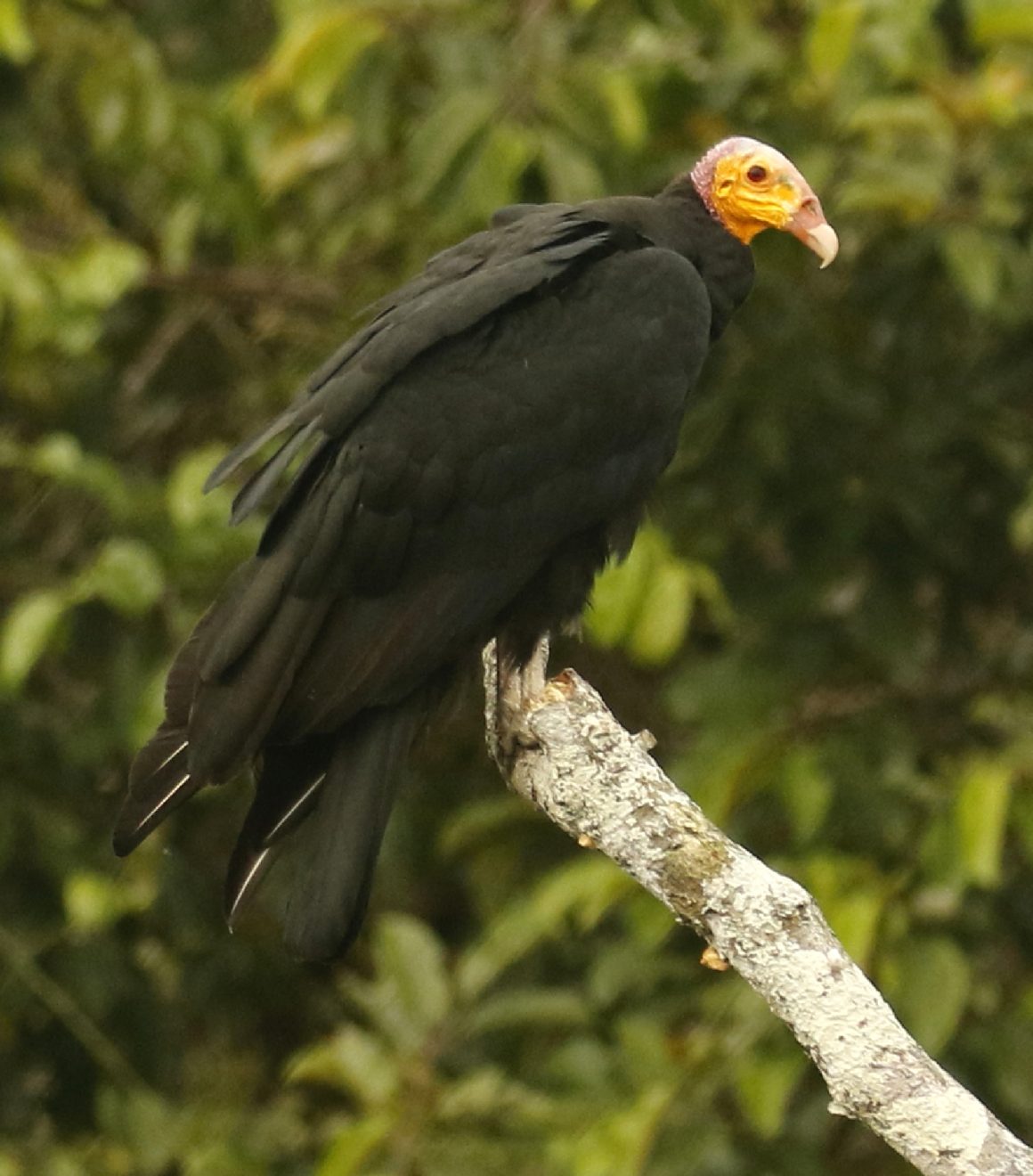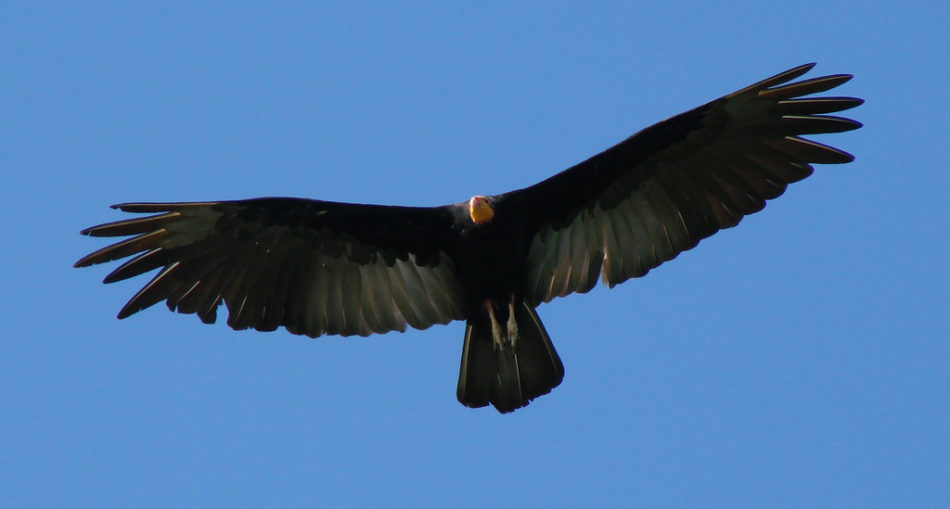In the country of Guyana, you will find many birds of prey, one such is the greater yellow-headed vulture. This vulture is extremely striking with its bold, black body color and a hint of orange-yellow on its head. Amazingly, this scavenger bird has a keen sense of smell, allowing them to find carcasses, even of small animals. But it can also feed at large carcasses with other species. It feeds slower than condors and large vultures, which means that it plays an important role in cleaning up all remaining meat by picking over the carcasses until little remain. As you continue to read, you will discover more interesting things about this fascinating vulture.
In the country of Guyana, you will find many birds of prey, one such is the greater yellow-headed vulture. This vulture is extremely striking with its bold, black body color and a hint of orange-yellow on its head. Amazingly, this scavenger bird has a keen sense of smell, allowing them to find carcasses, even of small animals. But it can also feed at large carcasses with other species. It feeds slower than condors and large vultures, which means that it plays an important role in cleaning up all remaining meat by picking over the carcasses until little remain. As you continue to read, you will discover more interesting things about this fascinating vulture.
Features Of The Greater Yellow-Headed Vulture
- Body Color – Its plumage is black with a green or purple sheen. The throat and the sides of the head are featherless. The skin on the head ranges in color from deep yellow to pale orange with a blue crown. The nape and the area near the nostrils are pale pinkish.
- Wings & Quill – The undersides of the wings are black, while the flight feathers are a lighter shade. The quills of the eleven primary feathers appear to be white when seen from above.
- Tail – The tail is rounded and long for a vulture, extending to or slightly beyond the tip of the closed wing. The sexes are outwardly similar.
- Head – The head is dull greyish in juveniles, which otherwise resemble adults.
- Iris – The irises of its eyes are red, its feet are black, and its beak is flesh-colored. The eye has a single incomplete row of eyelashes on the upper lid and two rows on the lower lid.
- Beak – Its beak is thick, rounded, and hooked at the tip.
- Legs – Because of its habit of urohidrosis, the scaly portions of its legs are often streaked white with uric acid. The front toes are long with small webs at their bases and are not adapted to grasping.
- Nostrils – The opening of the nostril is longitudinal and set in a soft cere, and the nostril lacks a septum. Like all New World vultures, the greater yellow-headed vulture lacks a syrinx, and is, therefore, unable to make any sound other than grunts or a low hiss.
- Weight & Length – The greater yellow-headed vulture is 64–75 centimetres (25–30 in) in length, with a wingspan of 166–178 centimeters (65–70 in), a tail length of 25–29 centimetres (9.8–11.4 in) and a weight averaging 1.65 kilograms (3.6 lb).

By TonyCastro – Own work, CC BY-SA 4.0, https://commons.wikimedia.org/w/index.php?curid=60383496
Scientific Classification Of The Greater Yellow-Headed Vulture
Greater Yellow- Headed Vulture – Cathartes melambrotus [Scientific Classification]
- Kingdom: Animalia
- Phylum: Chordata
- Class: Aves
- Order: Cathartiformes
- Family: Cathartidae
- Genus: Cathartes
- Species: C. melambrotus
Habitat Of The Greater Yellow-Headed Vulture
The greater yellow-headed vulture is found in the Amazon Basin of tropical South America; specifically in south-eastern Colombia, southern and eastern Venezuela, Guyana, French Guiana, Suriname, northern and western Brazil, northern Bolivia, eastern Peru, and eastern Ecuador.
Its natural habitat is tropical moist lowland forests. It is not generally found in high-altitude regions. It is common in heavily forested regions. It may wander over grasslands but rarely strays far from forested areas, which provide shelter and nesting areas.
Diet Of The Greater Yellow-Headed Vulture
The greater yellow-headed vulture is a scavenger and subsists entirely on carrion. It will eat roadkill or other animal carcasses. It prefers fresh meat but often cannot make the first cut into the carcass of a larger animal as its beak is not strong enough to tear into the tough hide. After a few days, the greater yellow-headed vulture will no longer feed on a piece of carrion, as the meat will begin to decay and become contaminated with microbial toxins. It will drink water from a pool, pond, or any receptacle provided. Like other vultures, they play an important role in the ecosystem by disposing of carrion which could otherwise be a breeding ground for disease.
Reproduction Of The Greater Yellow-Headed Vulture
Greater yellow-headed vultures do not build nests, but rather lay their eggs directly on cliffs, the floors of caves, the ground, or in the hollows of stumps. Eggs are cream-colored and blotched with brown spots, particularly around the larger end. Clutch size ranges from one to three, though two is the norm.
Chicks: The chicks are altricial—blind, naked and relatively immobile upon hatching, and grow down feathers later. The parents feed their young by regurgitating pre-digested food into their beak, where the chicks then drink it. Young fledge after two to three months
Greater Yellow-Headed Vulture Versus The Lesser Yellow-Headed Vulture
The greater yellow-headed vulture differs in appearance from the similar lesser yellow-headed vulture in several ways. Five ways they differ are:
- The greater yellow-headed vulture is larger than the lesser yellow-headed vulture, with a longer, broader tail.
- The plumage is a dark, glossy black in contrast to the lesser yellow-headed vulture’s browner plumage.
- Its legs are darker in color and its head is more yellow and less orange/pink than that of the lesser yellow-headed vulture. Its wings are broader and its flight is also steadier.
- Unlike the other members of the genus Cathartes, the greater yellow-headed vulture has relatively dark inner primaries, which contrast slightly with the paler secondaries and outer primaries.
- The greater yellow-headed vulture prefers to live in forests while the lesser yellow-headed vulture prefers to inhabit savannas, and it is more heavily built than the lesser yellow-headed vulture.
The Greater Yellow-Headed Vulture In Guyana
This article would have revealed some features of this bird, its diet, habitat, and reproduction. You would have seen that it is also quite different from the lesser yellow-headed vulture which is also found in Guyana. The greater yellow-headed vulture feeds on carrion and locates carcasses by sight and by smell, an ability which is rare in birds. It is dependent on larger vultures, such as the king vulture, to open the hides of larger animal carcasses, as its bill is not strong enough to do this. Like other New World vultures, the greater yellow-headed vulture utilizes thermals to stay aloft with minimal effort. It lays its eggs on flat surfaces, such as the floors of caves, or in the hollows of stumps. It feeds its young by regurgitation. Yes, the greater yellow-headed vulture is an amazing bird indeed!
Article References:
- https://en.wikipedia.org/wiki/Greater_yellow-headed_vulture
- https://en.wikipedia.org/wiki/Lesser_yellow-headed_vulture
- http://www.oiseaux-birds.com/card-greater-yellow-headed-vulture.html
- Image: https://upload.wikimedia.org/wikipedia/commons/b/b9/Great_Yellow-headed_Vulture.jpg







